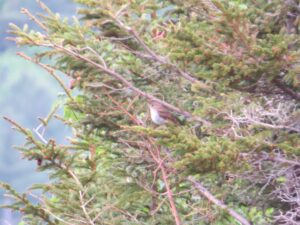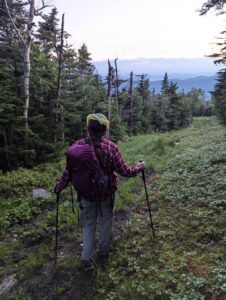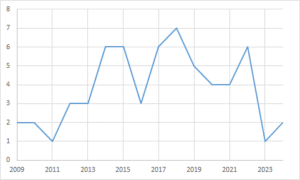(by Pam Hunt)

Bicknell’s Thrush (Catharus bicknellli) is the flagship bird species for high elevation conifer forest in the northeastern United States and southeastern Canada, breeding only above 2500’ from the Catskills of New York to southern Quebec and Nova Scotia. It spends the winter in forested parts of the Greater Antilles, almost entirely on the Island of Hispaniola (home of Haiti and the Dominican Republic). Populations of this regional endemic have been in gradual decline for decades, and over that time it has disappeared as a nesting species from isolated mountaintops along the southern edge of its range, including iconic peaks like Greylock in western Massachusetts and Monadnock in southwestern New Hampshire.

Here in the breeding range, the dense spruce-fir habitat preferred by Bicknell’s Thrush is largely intact. Development associated with ski areas and wind turbines is the most common source of direct habitat loss but is relatively rare since most habitat is protected in state parts and national forests. More insidious threats take the form of acid rain and climate change, which cause subtle changes to habitat quality that can take years to become apparent. Climate change is of particular concern, because some models predict that high-elevation conifer forest will shift upslope as the region warms, resulting in a reduced total area in which thrushes can nest.
New Hampshire Audubon has been monitoring Bicknell’s Thrush on Mittersill (the northern peak of Cannon Mountain) since 2009. These surveys originated from a land swap between the State and the White Mountain National Forest that allowed for expanded access to Mittersill for skiers. The thrush surveys are intended to determine if any changes on the mountain have impacts on the local Bicknell’s population. As shown in Figure 1, numbers are quite variable, but have been low the last two years, although high winds in 2024 likely made it hard to hear more distant singing birds.

Habitat loss in the winter range is a much higher concern. Haiti and the Dominican Republic have lost 90% and 50% of their original forest and much of what remains is still at risk. Because these are poor countries, local people exert immense pressures on natural resources just to feed their families and make a living, and even protected areas aren’t always safe. Enforcement of reserve boundaries, combined with economic policies to lift people out of poverty, are key conservation actions to ensure the continued survival of Bicknell’s Thrush, thus providing one of the clearest examples of why biologists need to consider the full annual cycle of migratory species when trying to conserve them.
State of the Birds at a Glance:
- Habitat: Spruce-Fir Forest
- Migration: Mid-distance
- Population trend: Decreasing
- Threats: Habitat Loss, Pollution, Climate Change
- Conservation actions: Protect critical winter habitat, Minimize impacts to breeding habitat
More information on “The State of New Hampshire’s Birds” is available here. Full species profiles in the format of “Bird of the Month” are now available here.
